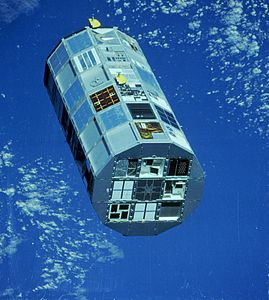Long Duration Exposure Facility
| LDEF | |
|---|---|

|
|
| Type: | Research satellite |
| Country: |
|
| Operator: | NASA |
| COSPAR-ID : | 1984-034B |
| Mission dates | |
| Dimensions: | 9700 kg |
| Size: | 9.20 m length; 4.29 m diameter |
| Begin: | April 6, 1984, 13:58 UTC |
| Starting place: | Kennedy Space Center , LC-39A |
| Launcher: | Challenger STS-41-C |
| Landing: | January 20, 1990, 09:35 UTC |
| Landing place: | Edwards Air Force Base |
| Orbit data | |
| Track height: | at the beginning: 473 km towards the end: 335 km |
| Orbit inclination : | 28.5 ° |
The Long Duration Exposure Facility ( LDEF ) was a satellite that served as a carrier for technical and scientific experiments in space. It was only used once.
LDEF consisted of a cylindrical aluminum structure, on the outer sides of which 86 experiment carriers were attached: twelve rows of six units each were in the jacket and seven each at the two ends. The satellite was 9.20 meters long and 4.29 meters in diameter. The structure had a mass of 3.6 tons; fully loaded it was 9.7 tons.
On April 6, 1984, the Challenger space shuttle launched the STS-41-C mission and brought the LDEF research platform into an almost circular earth orbit with an orbit height of 477 km.
The position in orbit was stabilized in such a way that the long axis of LDEF was aligned with the center of the earth.
Originally, LDEF was supposed to be recovered after ten months with the STS-51-D mission in February 1985. Due to postponements of the space shuttle program, the rescue date moved to the year 1986. This became impossible due to the disaster of the Challenger ( STS-51-L ) on January 28, 1986. The shuttle program was suspended for over two years.
The platform could only be recovered in January 1990 after almost six years of flight with the STS-32 mission . The orbit height had meanwhile dropped to 335 km and LDEF would have entered the earth's atmosphere in the following month. The Columbia approached LDEF on a trajectory that could contaminate the experiments as little as possible . After the capture, LDEF stayed on the robotic arm for four and a half hours to take pictures of all the experiment carriers. On January 20, the Columbia landed at Edwards Air Force Base and was piggybacked six days later on the Shuttle Carrier Aircraft (with LDEF in the cargo bay) to the Kennedy Space Center .
The investigation of the satellite brought, among other things, a lot of information about space debris and micrometeorites .
Individual evidence
- ↑ a b ESA: LDEF. Retrieved September 10, 2016 .
- ^ University of Reading: NASA Long Duration Exposure Facility (LDEF). Retrieved September 10, 2016 .
- ^ ARES: Hypervelocity Impact Technology's Other Impact Gallery. (No longer available online.) Archived from the original on December 13, 2016 ; accessed on October 7, 2018 (English). Info: The archive link was inserted automatically and has not yet been checked. Please check the original and archive link according to the instructions and then remove this notice.
See also
Web links
- Information from the SETAS NASA Langley Research Center via archive.org (English)
- Description of the experiment of the Institute for Pure and Applied Nuclear Physics in the LDEF mission
- NASA: The long Duration Exposure Facility (LDEF). Mission 1 experiment (English)
- ESA: LDEF (English)
